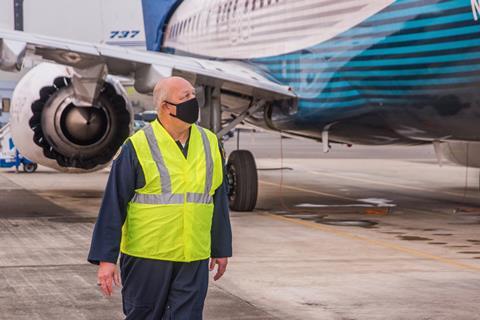The chief of the Federal Aviation Administration has assured lawmakers his office is strengthening aircraft self-certification rules in the wake of legislation stemming from two Boeing 737 Max groundings.
As part of an effort to heighten oversight, the FAA has also limited delegation to Boeing of some work related to 737 Max 10 and 777-9 certification, FAA administrator Steve Dickson says during an aviation committee hearing on 21 October.
“We’ve also limited delegated functions for critical design features” on those aircraft, Dickson says, without elaborating.

Boeing is working to certificate both aircraft, with plans to begin delivering the types in 2023.
“We are delegating fewer responsibilities to manufacturers, and we are demanding more transparency from them,” Dickson says during a House Committee on Transportation and Infrastructure hearing. “In the nearly three years since these tragedies, we have made tangible and lasting safety improvements.”
Lawmakers called Dickson to testify for the purpose of reviewing changes made by the FAA in response to a 2020 law aimed at improving the aircraft-certification process.
A Lion Air 737 Max 8 crashed in October 2018, followed in March 2019 by the crash of an Ethiopian Airlines aircraft of the same model. The accidents killed 346 people and set in motion broad criticism about Boeing’s design of the jet and the FAA’s oversight.
The resulting law, signed by President Donald Trump in December 2020, requires the to FAA review aviation manufacturers’ “Organization Designation Authorizations” (ODA) – programmes under which the FAA delegates certification work to manufactures.
“In general, our approach to aircraft certification and safety oversight has changed,” Dickson says. “The FAA’s relationship with manufacturers is evolving. We are prioritising oversight of manufacturers and working to focus that oversight on safety critical areas.”
Dickson says the FAA is now “demanding more transparency” from aerospace manufacturers and delegating less regulatory oversight to them.
The law also mandates that the FAA hire more technical staff and address pilot performance factors, and it ordered the FAA to require aircraft manufacturers to have organisation-wide safety structures called “safety management systems” (SMS).
Dickson says the FAA has accomplished nearly 200 of the law’s 300 requirements, though many outstanding provisions involve rules yet to be finalised.
“We expect to implement significant changes to our policies and procedures for delegating certification authority to private entities,” Dickson’s prepared testimony says.
Following the 737 Max crashes, Boeing faced allegations that its managers pressured employees in its ODA division. The FAA faced criticism about its approval of “changed” products, such as the 737 Max, which is an updated variant of a model first certificated in 1967. Additionally, the crashes sparked questions about how pilots should be expected to respond to cockpit problems.
Dickson tells lawmakers the FAA is developing guidance to ensure changes made to aircraft designs “are evaluated from a total aircraft perspective”. The FAA is also reviewing assumptions related to pilot-response times.













































